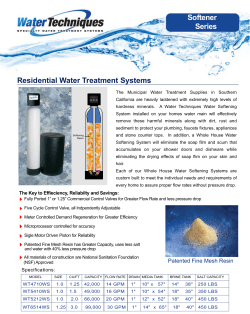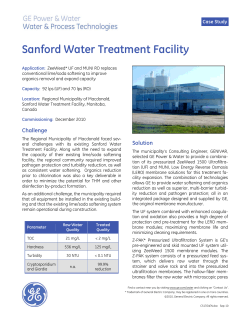
INDBYDELSE - Rønde Kunstforening
Journal nr. 7509/13 Uppsala Vatten, Sverige: Erfaringer med blødgøring Fra Philip McCleaf Processingeniør Uppsala Vatten 16.6. 2010, sendt som mail Dear Ms. Von Bülow I have just finished discussing your questions with some of my colleagues and our responses to your questions can be found below in the text of your original message. However, a little background information concerning softening here in Uppsala may help clarify the situation. Central softening has been in operation in Uppsala since approximately October 2007. Previously, Uppsala’s drinking water had a calcium level of approximately 85-100 mg/l and magnesium 9-16 mg/l. That is a hardness level of about 14-18 German degrees of hardness (dH). The alkalinity of our water was approximately 280-330 mg/l as bicarbonate and pH 7,2. The central softening process we utilize is a fluidized pellet bed reactor process wherein slaked lime is dosed to the raw water and the pH is increased to pH 9-9,5. At this elevated pH the chemical reaction occurs wherein soluble calcium is crystallized as calcium carbonate and builds pellets in the fluidized reactor. The calcium content is about 35 mg/l with bicarbonate alkalinity 110 mg/l and pH 8,3 in the water distributed to our customers. Thus hardness of our water is reduced to between 7-8 dH without affecting the magnesium content of the water. Again note that only calcium hardness is removed in our softening process not magnesium hardness. Best Regards, Philip McCleaf Från: Dorthe von Bülow [mailto:doby@ke.dk] Skickat: den 16 juni 2010 09:56 Till: McCleaf Philip Ämne: Vs: Copenhagen Water Department seeks information about softening Dear Philip McCleaf, Allow me to remind you of my prior mail to you. I´d appreciate very much if you could help me with some information on your experiences with softening, especially issues relating to the customers´ interests and reactions. Kindest Regards/ Med venlig hilsen Dorthe von Bülow Water Supply and Sewage Department Direkte tlf: 2795 4672 E-mail: doby@ke.dk Københavns Energi A/S • Ørestads Boulevard 35 • 2300 København S • CVR: 10073022 • tlf. 3395339 Tænk på miljøet - før du printer! ----- Videresendt af Dorthe von Bülow/4530 Salg & Produkt/KBHE den 16-06-2010 09:50 ----- Dorthe von Bülow/4530 Salg & Produkt/KBHE Salg & Service Vand & Afløb 2795 4672 21-05-2010 12:09 TilPhilip.McCleaf@uppsalavatten.se cc EmneCopenhagen Water Department seeks information about softening Dear Philip McCleaf, As I mentioned on the phone we are right now investigating the possibilities and consequences of softening the Copenhagen drinking water. Our water holds 20 German degrees right now. We deliver water to Copenhagen city and to 18 other municipalities outside Copenhagen, altogether 54 mio. m3 water yearly to 1 mio. citizens. We are investigating the technical and environmental issues relating to softening. In addition, we are interested in possible responses from various categories of consumers and companies. I am working in Sales and Services Section and have been assigned the task of looking into issues relating to consumer interests. I understand that it is fairly recent that softening of drinking water have been introduced in Uppsala. Hence, I would very much like to know about your experiences in this field, and I would appreciate very much if you could answer my questions below: 1. What was the reason for implementing softening of drinking water in Uppsala? And what were the main arguments for doing it? The main reasons for implementing softening in the drinking water were to reduce hardness deposits in heating systems and household appliances, reduce the amount 2. 3. 4. 5. 6. 7. 8. of laundry and dishwashing detergents, reduce the amount of copper corrosion in consumers’ piping systems, and decrease the use of salt-regenerated ion exchange softening equipment by our customers. The reduction of copper corrosion in turn is aimed at reducing the amount of dissolved copper in our wastewater and in our wastewater sludge residuals. The ultimate goal is the use of our wastewater sludge as a soil amendment. Was an investigation of customers´ interests and reactions undertaken prior to the implementation of softening? If so, which groups of customers did the study involve? No formal structured investigation of interests or reactions was made. Did you foresee any problems or negative responses from the customers? Of what kind? There was some concern about the possible reduction of magnesium and the possible health benefits provided by magnesium. However the process that we utilize does not significantly reduce the amount of magnesium in the drinking water. Did you encounter any resistance from companies that produce,, install and service decentralized softening systems? And has it turned out to be a problem afterwards for this type of sector or business? There were some mixed signals sent to our customers. On one hand we the “water provider” informed our customers that private/home owner water softening would not be needed after central softening was implemented. While purveyors of home water softening devices advertised that private/home water softening would still be required. Approximately 50-100 calls were received by us from our customers asking for a clarification. And likewise, has it caused problems for laundries, restaurants, hotels etc. who have invested in their own decentralized systems? Central water softening has not caused problems for these customers, but since they had become acclimated to almost completely softened water from their decentralized systems, many have chosen to continue operating their own decentralized softening systems. Especially those utilizing hot water above 90 C for example industrial dishwashing. One could say they had too high expectations of central water softening or did not understand the degree of softening afforded by their own decentralized systems. Have you experienced any positive reactions from customers regarding less use of soap, washing powder and chemicals for cleaning or prolongation of service life of household appliances (wasking machine, dish washer, coffee machine etc. We have experienced positive reaction about the decreased need for cleaning of calcium carbonate scale from shower, bathtubs and sinks. Have you experienced any positive developments among children regarding atopic eczema? We are not aware of any problems or developments. And finally, did you launch any kind of information campaigns among customers regarding the implementation of softening? Yes, we had an information campaign which began around December 2003 a copy of which is attached. From 2003 until operation of the plant in 2007 we published information in the local newspapers and in our newsletter that is sent out to all our customers. I would appreciate very much if you could send me the contact information you mentioned from Holland/Amsterdam. Mr. Bas Brouwer, RWB Water Services, PO Box 223, 7600 AE Almelo, tel +31 546 545 025 Best Regards Dorthe von Bülow Water and Sewage Department, Copenhagen Energy Dear Mr. Philip McCleaf, Sendt som mail d. 21. 6. 2010: Thank you very much for your dedailed replies to our questions, it is most helpful in our investigations regarding softening. We understand that you published information about softening to the customers from 2003 to 2007, a very useful information to us. In your reply you also mention an information campaign from December 2003. We would very much like to see a copy of that campaign, if possible. Best Regards Dorthe von Bülow Copenhagen Energy
© Copyright 2025









